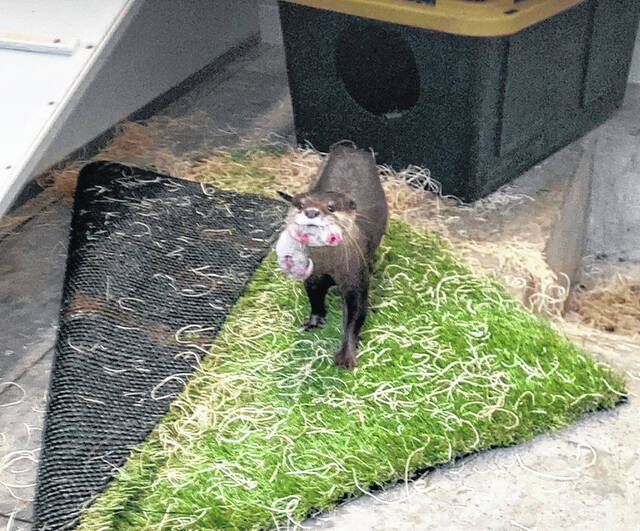FORT FISHER —For the second time in less than a year, North Carolina Aquarium at Fort Fisher (NCAFF) staff is celebrating the arrival of a trio of Asian small-clawed otter pups, born Jan. 31. The pups are growing and bonding with their parents, Leia and Quincy, and siblings Stella, Mae, and Selene, behind the scenes at the NCAFF Otters on the Edge habitat.
Leia’s second successful pregnancy and delivery represent continued success in the Association of Zoos & Aquariums (AZA) Species Survival Plan®(SSP) Program. The 4-year-old is among 13 breeding female otters in the AZA SSP Program in the United States. Asian small-clawed otters are a vulnerable species in their native habitats of Indonesia, southern China, southern India, Southeast Asia, and the Philippines.
“Being a part of the AZA SSP program and continuing to support the survival of this vulnerable species is very rewarding to all of us at the Aquarium. We are keeping a close eye on the family since now there are siblings in the mix and just like with Stella, Mae, and Selene, it is important that the family have a safe and quiet place to bond with their newest members,” said Shannon Anderson, aquarist and otter keeper, NCAFF.
Here’s what we know
The otter team spotted a single otter pup early on Tuesday, Jan. 31, with Leia still in labor, and shared the big news with the Aquarium team.
Later in the morning, the otter team reported spotting three pups.
The new pups, like their older sisters, are under the attentive care of parents, Leia and Quincy.
Siblings Stella, Mae, and Selene have been keeping their distance from the nest and have been submissive to Leia when she exits the nest.
The otter team will confirm the gender of the new arrivals in the coming days, so watch NCAFF social media for a gender reveal on Saturday, Feb. 4—Facebook, Twitter, Instagram, YouTube.
Things to know about Asian small-clawed otters
Gestation is 68-72 days.
False pregnancies are common in this otter species.
Stillbirths are also very common.
It is not unusual for some species to be unsuccessful in raising the first few litters, and they need the opportunity to develop parental skills.
These pups may be fragile, and their outcome will become clear as they grow older.
Otter pups’ development stages
2.5 weeks—use legs to move around in their den box/eyes begin to open/teeth begin to develop.
6.5 weeks — begin leaving the den box on their own.
7 weeks—trying solid food/eyes fully open.
8 weeks—pups begin swim lessons in about four inches of water.
13 weeks—teeth development complete.
17.5 weeks—coats have waterproofing oil and pups swim in the pool.
Next steps
The plan is for the Leia and Quincy growing otter family to remain behind the scenes, giving them an opportunity to teach parenting skills to Stella, Mae, and Selene and also to ensure the new pups have a safe place to thrive.
Asta and Ray will go back into the larger habitat Saturday and plans are to switch the families in the coming weeks.
The veterinary and otter teams will monitor the new pups in a hands-off approach as much as possible to provide space for Leia and Quincy to bond with them and succeed as parents.
The new pups will not be in public view until they reach important milestones, including swimming proficiently and eating solid foods.
About the North Carolina Aquarium at Fort Fisher
The North Carolina Aquarium at Fort Fisher is just south of Kure Beach, a short drive from Wilmington, on U.S. 421. The site is less than a mile from the Fort Fisher ferry terminal. Hours: 9 a.m. to 5 p.m. daily. Admission: $12.95 for ages 13-61; $10.95 for children ages 3-12; $11.95 for seniors (62 and older) and military with valid identification; EBT card holders: $3. Free admission for children 2 and younger and N.C. Aquarium Society members and N.C. Zoo members.


